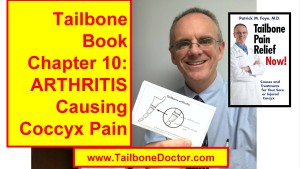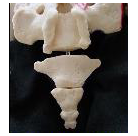Tailbone Book, Chapter 10: Arthritis Causing Coccyx Pain, Tailbone Pain
- This is the next in a series of coccyx pain videos, giving you highlights from the chapters of Dr. Foye’s book, “Tailbone Pain Relief Now!”
The actual VIDEO is at the bottom of this page.
Here is the TEXT from the video:
- Hi I’m Dr. Patrick Foye.
- I’m an M.D. or Medical Doctor.
- And I’m the Director of the Coccyx Pain Center, or Tailbone Pain Center, here in the United States.
- I’m online at www.TailboneDoctor.com.
- In this video we’re going to talk about ARTHRITIS as a cause of tailbone pain.
- And this is the next in my series of videos going chapter by chapter through my book “Tailbone Pain Relief Now!”
- I’m just doing short videos that give a glimpse as to some of the content that’s within each chapter.
- And presenting it here in a video format so that it allows us to have an opportunity to interact.
- And you can post your comments or questions or thoughts or your experiences with arthritis related to the tailbone down below.
- And it gives us all a chance to interact down in the comments section.
- So again back to the book.
- We’re looking now at Chapter 10 within the book which is Arthritis of the Tailbone.
- And most people are familiar with arthritis as a cause of pain in other parts of the body.
- So you may have arthritis at your knee or at your hip.
- Many people have arthritis within the small joints within their fingers.
- And similarly people can have arthritis within the small joints within the coccyx.
- And unfortunately many, many physicians forget to think about arthritis as a cause of coccyx pain.
- Even though they would know enough to think about arthritis as a cause of pain in your fingers or your hip or your knee.
- So let’s take a look for comparison again.
- Just showing here where one joint meets the next… where one BONE, rather, meets the next.
- That’s the joint.
- And normally there’s a nice smooth appearance between one end of the one bone and the next.
- But when there’s arthritic changes that happen that make it look abnormal.
- And to show you a illustration from my book, this kind of overdramatizes the way the illustrator happened to draw it here.
- But it makes the point which is you can see here the bones of the of the coccyx up one on top of the other.
- And down in these lower joints in this example you can see that the bone surfaces are nice and smooth.
- The bones may have a nice squared off appearance at the joint where one bone meets the next bone.
- But at this bone up here you can see it doesn’t look so nice and neat and smooth anymore.
- Instead it looks very kind of jagged or hazy or ragged around the edges.
- And that’s because there’s arthritis at that joint.
- There’s wear and tear at that joint.
- Now this is sort of drawn in a very dramatic way for the illustration in the book.
- It’s probably in most cases a little more subtle.
- Something more like this where again over here you would have a nice neat joint as shown here as opposed to the arthritis.
- Showing that the wear and tear within the joint over there on this part of the image.
- So also at the edge of the joint you may have what’s called an osteophyte which is a little bit of a lip where the bone gets a little bit wider at that margin at the joint that has the arthritis.
- So that’s a little bit about arthritis and some of the questions that come up about arthritis.
- Well there are different types of arthritis.
- The most common is osteoarthritis, which is also referred to as “degenerative joint disease.”
- And this is normal wear and tear.
- All of us go through life and we move around.
- We put weight onto our joints.
- Whether that’s by walking or running or sitting we’re putting weight onto our different joints throughout the body.
- And some wear and tear happens at the joint over time.
- And that wear and tear is referred to as arthritis.
- The scenario can also happen where somebody can have trauma that causes arthritis.
- Very commonly, you have a football player who has trauma to the knee and then at that knee joint they end up having arthritis much, much sooner… (many, many years or decades soone ) than they have normal aging arthritis at the same joint on the opposite side of the body.
- So at the tailbone you can have trauma where maybe you had a slip and fall.
- You landed on the tailbone.
- You had an injury to the tailbone many, many, many years ago.
- And it sort of did okay for a while.
- Maybe for years or decades.
- But arthritis starts to set in at that injured joint over time.
- So that’s where you have trauma causing arthritis.
- So whether the arthritis is caused by trauma or whether it’s just the micro-trauma of gradual wear and tear over the years, either way you can have arthritis at the tailbone.
- The arthritis can cause pain because instead of having a nice smooth joint where one joint meets the next you have this irregular surface and that irregular surface is going to be associated with some extra friction now between one bone and the next and with any movement there.
- And that can be quite painful for patients at the tailbone, just as it can be painful when they have arthritis in other parts of the body as well.
- The other things we can talk about with arthritis is treatment of arthritis and diagnosis of arthritis.
- So in terms of diagnosis really you need imaging studies to diagnose arthritis.
- Whether that’s at the tailbone or at other parts of the body.
- Most commonly this involves getting x-rays.
- But you can get information from MRI and CT scans as well.
- But really the x-rays are more or less the typical gold standard for diagnosing typical arthritis.
- The x-rays need to be done in the proper way.
- And what I mean by that is that it’s very, very common that the x-rays or other imaging studies at the tailbone will not be done in a way that adequately shows the tailbone.
- So the imaging studies may be done of the lumbar spine which is higher up.
- Or the imaging studies ARE done of the tailbone, BUT it doesn’t do the image at the proper angle in order to see the joints nice and clearly in order to make the diagnosis of arthritis.
- So it becomes really important when the imaging studies are being done that the ordering physician understands and has experience in treating tailbone pain and orders the proper tests.
- And also that the radiology technician does the tests properly.
- And then that the radiologist that’s reading the images actually looks at the tailbone and comments on it and evaluates for some of these things.
- And unfortunately it’s very, very common that there’s breakdown at each and every one of those steps along the way.
- So although if I had arthritis within my finger the x-rays would be done properly.
- The radiologist would read it properly etc.
- But if I had arthritis instead of at my finger, if I had the arthritis at my tailbone, then often the system just sort of breaks down because most people are not familiar with treating tailbone pain.
- As far as treatment of arthritis, the first step in treatment is actually having an accurate diagnosis in the first place.
- And that’s why the imaging studies and the evaluation are so important.
- The treatment sometimes can involve putting medication locally at the spot such as by a small local injection.
- But we’re going to get into treatment in another chapter later within the book.
- So we’ll have a chance to talk more about that there.
- But for this purpose let’s just say that unless you make an accurate diagnosis in the first place, it’s very difficult to have a logical treatment plan.
- Because if you just are labeled as having “tailbone pain” overall, which they call coccydynia, withOUT having a diagnosis made as to what’s CAUSING the tailbone pain, well then you don’t have a clear direction for what way you’re going to go with your treatment options.
- Or you may have an injection done but they don’t do the injection at the specific joint within the coccyx that has the arthritis because they haven’t made that diagnosis in the first place.
- So I hope that information is helpful about arthritis in the tailbone.
- Definitely post your comments, questions, and stories related to tailbone arthritis down below.
- So that gives us a chance to read and comment back on those.
- If you’re looking for a copy of the entire book for more information on arthritis of the tailbone and lots of other things about the tailbone, the book is available online.
- The easiest way to get it online is to go to the website www.TailboneBook.com and that’ll have the links to different amazon pages for different countries etc.
- You can get it as a printed book which is 272 pages in paperback, or you can get the electronic book, the eBook version, if that’s easier for you.
- You can get that pretty much anywhere in the world that has internet access.
- You can download the electronic book and have access to all of the same information.
- If you’re looking specifically for me online, the easiest place to find me is at the website www.TailboneDoctor.com.
- So if you’re looking for more educational content, I have lots of educational videos and online articles and information written specifically about the tailbone and tailbone pain.
- You can find all of that there.
- Or if you’re looking to come to the Tailbone Pain Center for evaluation and treatment, all of that information is there as well at www.TailboneDoctor.com.
- So I hope the information is helpful for you.
- I’ll be looking for your comments down below regarding arthritis at the tailbone.
- Bye bye.
Here is the actual VIDEO:
Here is the screenshot thumbnail image for the video:

Chapter 10 of Tailbone Pain Book, ARTHRITIS, Coccyx Pain, osteoarthritis, degenerative joint disease, DJD
To get your copy of the book “Tailbone Pain Relief Now!” go to: www.TailboneBook.com
For more information on coccyx pain, or to be evaluated at Dr. Foye’s Tailbone Pain Center in the United States, go to: www.TailboneDoctor.com
Latest posts by Patrick Foye, M.D. (see all)
- Coccygectomy: Expected Recovery and Return to Work after surgery for coccyx pain, tailbone pain. - November 28, 2023
- PRP Platelet Rich Plasma or Prolotherapy for Tailbone Pain, Coccyx Pain - October 25, 2023
- Reasons for Normal X-rays and MRI Despite Tailbone Pain, Coccyx Pain - October 3, 2023

